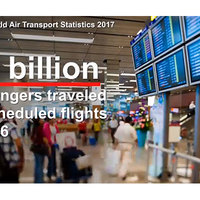[ad_1]
MONTREAL – The International Air Transport Association (IATA) announced industry performance statistics for 2016 showing that system-wide, airlines carried 3.8 billion passengers on scheduled services last year, an increase of 7% over 2015, representing an additional 242 million air trips. This information is included in the 2017 edition of the IATA World Air Transport Statistics (WATS), the yearbook of the airline industry’s performance.
Highlights of the 2016 airline industry performance:
Passenger
Once again, airlines in the Asia-Pacific region carried the largest number of passengers. The regional ranking (based on total passengers carried on scheduled services by airlines registered in that region) is:
- Asia-Pacific 35% market share (1.3 billion, an increase of 11.3% compared to 2015)
- Europe 26% market share (992.4 million, up 6.1% over 2015)
- North America 24% market share (911.5 million, up 3% over 2015)
- Latin America 7% market share (275.1 million, up 1.8% from 2015)
- Middle East 5% market share (206.1 million, an increase of 9.1% over 2015)
- Africa 2% market share (84 million, up 6% over 2015).
The top five airlines ranked by total scheduled passengers carried (domestic and international) were:
- Southwest Airlines (151.8 million)
- American Airlines (144.2 million)
- Delta Air Lines (143.3 million)
- China Southern Airlines (114.5 million)
- Ryanair (112 million)
The top five international/regional passenger airport-pairs were almost the same as they were in 2015, and all were within the Asia-Pacific region:
- Hong Kong-Taipei (5.2 million, up 2.1% from 2015)
- Jakarta-Singapore (3.4 million, up 0.9% from 2015))
- Bangkok Suvarnabhumi-Hong Kong (3 million, a decrease of 3.14% from 2015)
- Kuala Lumpur–Singapore (2.8 million, up 3.3% from 2015)
- Hong Kong-Seoul (2.8 million, down 15% from 2015)
The top five domestic passenger airport-pairs were also all in the Asia-Pacific region:
- Jeju-Seoul Gimpo (11.6 million, up 4.6% over 2015)
- Sapporo-Tokyo Haneda (7.7 million, down 1.2% from 2015)
- Fukuoka-Tokyo Haneda (7.3 million, a decrease of 4% from 2015)
- Melbourne-Tullamarine-Sydney (7.3 million, down 4.6% from 2015)
- Hanoi-Ho Chi Minh City (6.4 million, up 16.2% from 2015)
Passenger Traffic by Nationality
A new feature available this year in the WATS+ edition is the ranking of passenger numbers in terms of nationality (citizenship). Highlights include:
- US Citizens are the world’s most prevalent travelers. Some 810 million passengers traveled on US passports in 2016 comprising 21% of all passengers worldwide.
- Internationally, American citizens also took top place, comprising 9.5% of all travelers. This was followed by citizens of the UK (7.8%), Germany (6.5%), China (6.4%) and France (4.1%).
- Domestically, US citizens were also the most prevalent travelers at 29.9%, followed by China (19.0%), India (5.2%), Indonesia (4.4%) and Japan (3.5%).
New Model Airlines
New Model Airlines (NMAs), a classification that includes Low Cost Carriers (LCCs), accounted for 28.3% of all passengers in 2016, up from 27.1% of passengers in 2015. Network carriers account for 69.5% of total passengers while leisure carriers² contributed 2.2% to passenger volumes.
Measured in revenue passenger kilometers (RPK), NMAs accounted for 20% of global traffic, reflecting the concentration of this sector on short-haul flying. By the same RPK measure, network carriers accounted for 77% of traffic with leisure carriers comprising 3% of traffic.
Airline Alliances
Star Alliance maintained its position as the largest airline alliance in 2016 with 38% of total scheduled traffic (in RPK), followed by SkyTeam (33%) and oneworld (29%).
You can read more of the news on source
 Travelsmart
Travelsmart



